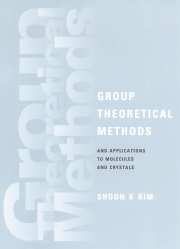Book contents
- Frontmatter
- Contents
- Preface
- List of symbols
- 1 Linear transformations
- 2 The theory of matrix transformations
- 3 Elements of abstract group theory
- 4 Unitary and orthogonal groups
- 5 The point groups of finite order
- 6 Theory of group representations
- 7 Construction of symmetry-adapted linear combinations based on the correspondence theorem
- 8 Subduced and induced representations
- 9 Elements of continuous groups
- 10 The representations of the rotation group
- 11 Single- and double-valued representations of point groups
- 12 Projective representations
- 13 The 230 space groups
- 14 Representations of the space groups
- 15 Applications of unirreps of space groups to energy bands and vibrational modes of crystals
- 16 Time reversal, anti-unitary point groups and their co-representations
- 17 Anti-unitary space groups and their co-representations
- Appendix Character tables of the crystal point groups
- References
- Index
Preface
Published online by Cambridge University Press: 12 November 2009
- Frontmatter
- Contents
- Preface
- List of symbols
- 1 Linear transformations
- 2 The theory of matrix transformations
- 3 Elements of abstract group theory
- 4 Unitary and orthogonal groups
- 5 The point groups of finite order
- 6 Theory of group representations
- 7 Construction of symmetry-adapted linear combinations based on the correspondence theorem
- 8 Subduced and induced representations
- 9 Elements of continuous groups
- 10 The representations of the rotation group
- 11 Single- and double-valued representations of point groups
- 12 Projective representations
- 13 The 230 space groups
- 14 Representations of the space groups
- 15 Applications of unirreps of space groups to energy bands and vibrational modes of crystals
- 16 Time reversal, anti-unitary point groups and their co-representations
- 17 Anti-unitary space groups and their co-representations
- Appendix Character tables of the crystal point groups
- References
- Index
Summary
This book is written for graduate students and professionals in physics, chemistry and in particular for those who are interested in crystal and magnetic crystal symmetries. It is mostly based on the papers written by the author over the last 20 years and the lectures given at Temple University. The aim of the book is to systematize the wealth of knowledge on point groups and their extensions which has accumulated over a century since Schönflies and Fedrov discovered the 230 space groups in 1895. Simple, unambiguous methods of construction for the relevant groups and their representations introduced in the book may overcome the abstract nature of the group theoretical methods applied to physical chemical problems.
For example, a unified approach to the point groups and the space groups is proposed. Firstly, a point group of finite order is defined by a set of the algebraic defining relations (or presentation) through the generators in Chapter 5. Then, by incorporating the translational degree of freedom into the presentations of the 32 crystallographic point groups, I have determined the 32 minimum general generator sets (MGGSs) which generate the 230 space groups in Chapter 13. Their representations follow from a set of five general expressions of the projective representations of the point groups given in Chapter 12. It is simply amazing to see that the simple algebraic defining relations of point groups are so very far-reaching.
- Type
- Chapter
- Information
- Publisher: Cambridge University PressPrint publication year: 1999

